MEA Vegetable Oil Market Size
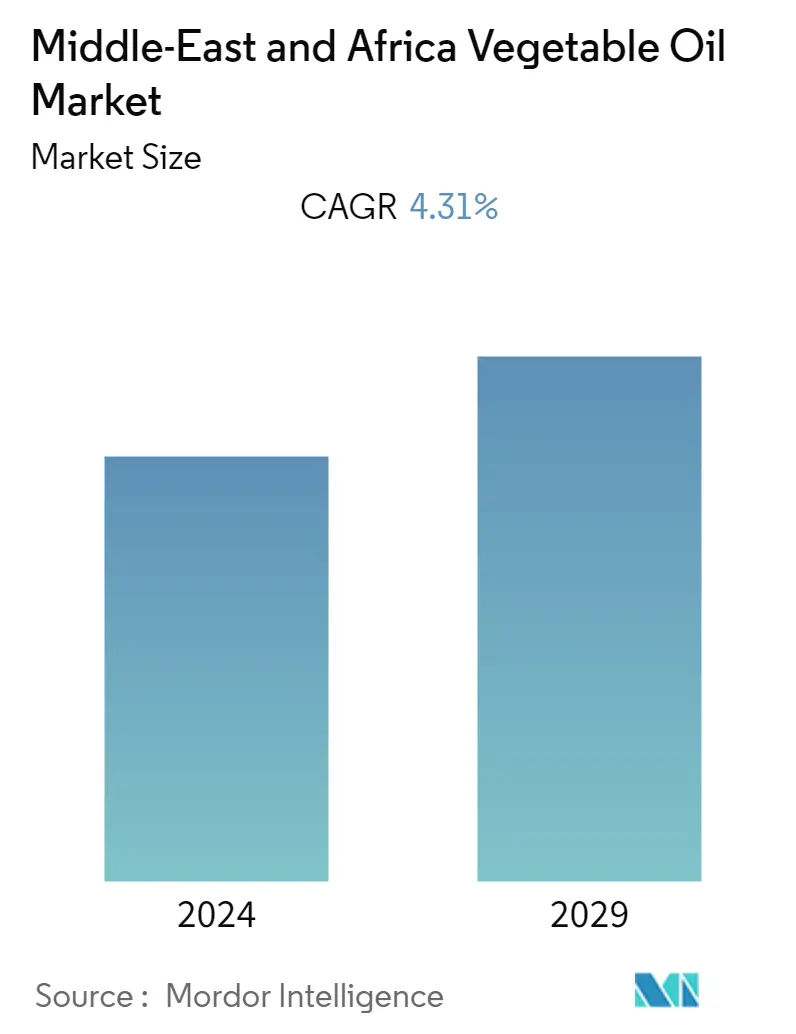
| Study Period | 2019 - 2029 |
| Base Year For Estimation | 2023 |
| Forecast Data Period | 2024 - 2029 |
| Historical Data Period | 2019 - 2022 |
| CAGR | 4.31 % |
| Market Concentration | Low |
Major Players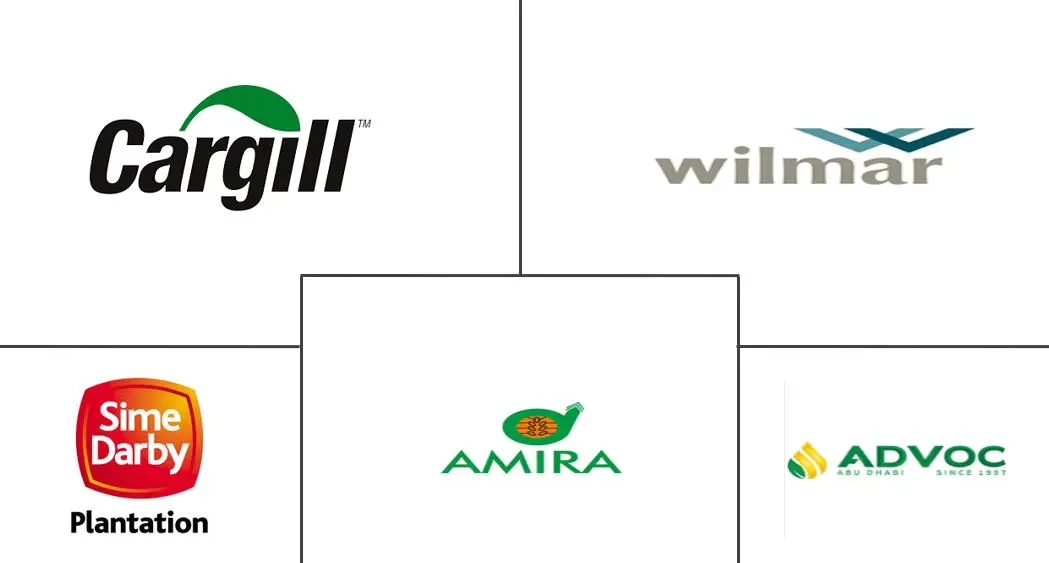
*Disclaimer: Major Players sorted in no particular order |
MEA Vegetable Oil Market Analysis
The Middle-East and Africa vegetable oil market is projected to register a CAGR of 4.31% during the forecast period (2022 - 2027).
According to The United States Department of Agriculture report, the growth rate of rapeseed oil consumption in the Middle Eastern country like the United Arab Emirates was stagnant, accounting for 17 thousand metric ton in 2017 and 2018. However, it is projected to grow in the forecast period. The rise in the export of canola oil is witnessed in the regional market. Additionally, due to the import opportunity posed by the ongoing trade war between China and Canada, the United Arab Emirates is projected to augment further the export of canola oil to the Chinese market.
The Middle Eastern region uses vegetable oil, such as sunflower oil, soybean oil, and others, in personal care applications. According to a USDA report, the Middle Eastern region imported 248 thousand metric ton of soybean oil in 2018-2019.
Cargill Incorporate is the leading player operating in the country with its wide range of offerings, including corn oil, rapeseed oil, soybean oil, sunflower oil, and palm oil, among others.
MEA Vegetable Oil Market Trends
This section covers the major market trends shaping the MEA Vegetable Oil Market according to our research experts:
Increasing Demand for Fortified Edible Oil
Palm oil crop remained the most effective crop globally in terms of oil production per unit crop area. About one hectare of oil palm crop produces ten times higher oil than any other oilseeds. For instance, DH Brothers Industries (Pty) Ltd supplies deodorized palm olein to Mcdonald's and various fast-food restaurants, as well as other industrial users of palm olein and other palm products. The animal feed and pet food industry is the next major industry influencing the demand for edible oils such as palm oil, corn oil, and many more in Middle-Eastern countries, primarily Saudi Arabia and the United Arab Emirates. Additionally, corn oil is used in the feed application. The boost in palm oil application is owing to lowered prices compared with soybean oil, sunflower oil, and olive oil. The oil-rich nation (Saudi Arabia imports most of the palm oil from Malaysia and Indonesia, specifically for its food processing units. Palm oil has several functional benefits, such as brain health, anti-aging, and vitamin A. Owing to low trans-fat content and affordable prices, the market for palm oils in the regions of Middle-East and Africa.
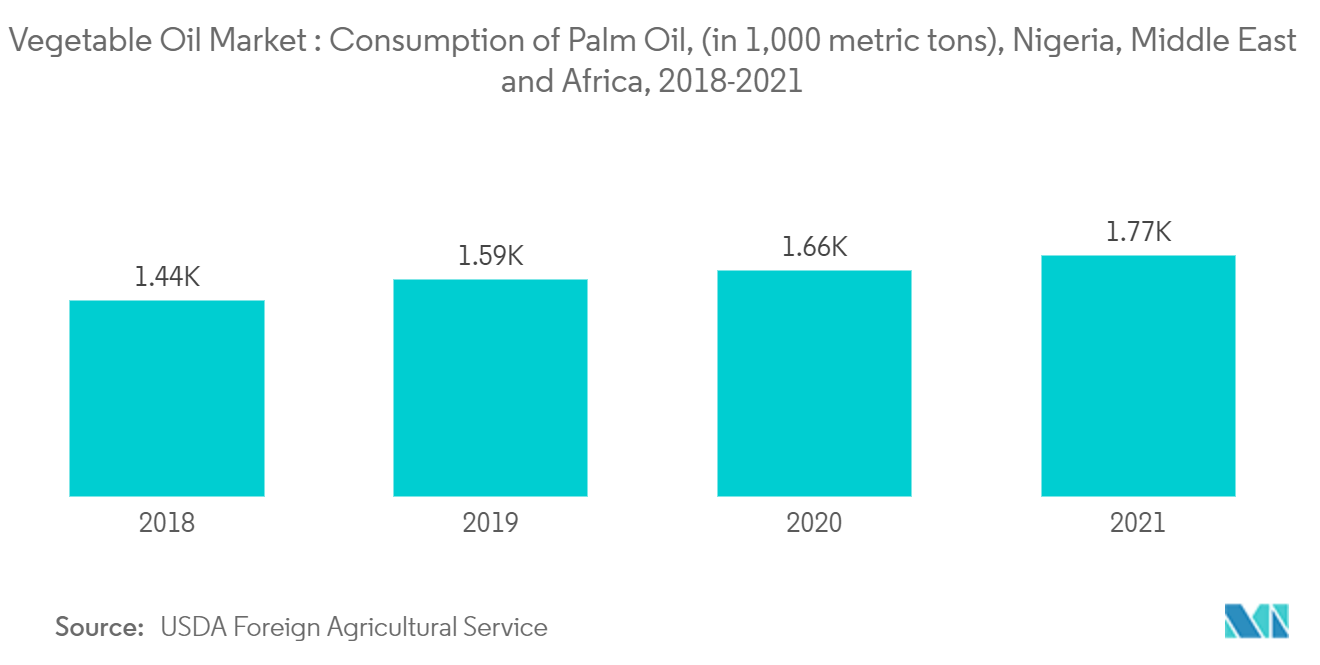
South Africa Held the Largest Share in the Market
According to a USDA report, sunflower and soybean oil accounted for 56% share of vegetable oil produced in the country, accounting for 209 and 198 thousand metric ton of sunflower and soybean oil production, respectively. South Africa is the highest producer of Sunflower oil, with an estimated 464,000 tons of oil from seeds in the year 2019 to 2020, and it has been predicted that for the years 2021-2022, it has the capability to produce near about 507,000 tons. The South African palm oil market is strongly dependent on imports from Indonesia and Malaysia for its application in cosmetics and food. In South Africa, local manufacturers have to struggle in purchasing 100% RSPO-certified palm oil, as most of the sustainable palm oil and its products are sold in the European region, which boosts their economy at a much higher rate. To embark sustainability among consumers, the country has over 16 RSPO members, where consumer good manufacturing companies include DH Brothers Industries (Pty) Ltd and Rhodes Food Group of South Africa. The extensive application of palm oil in different food and beverage products such as bakery products, dairy products, savory snacks, confectionery, margarine and fats, and others, followed by increasing foodservice outlets, is one of the major factors driving the palm oil market in the country.
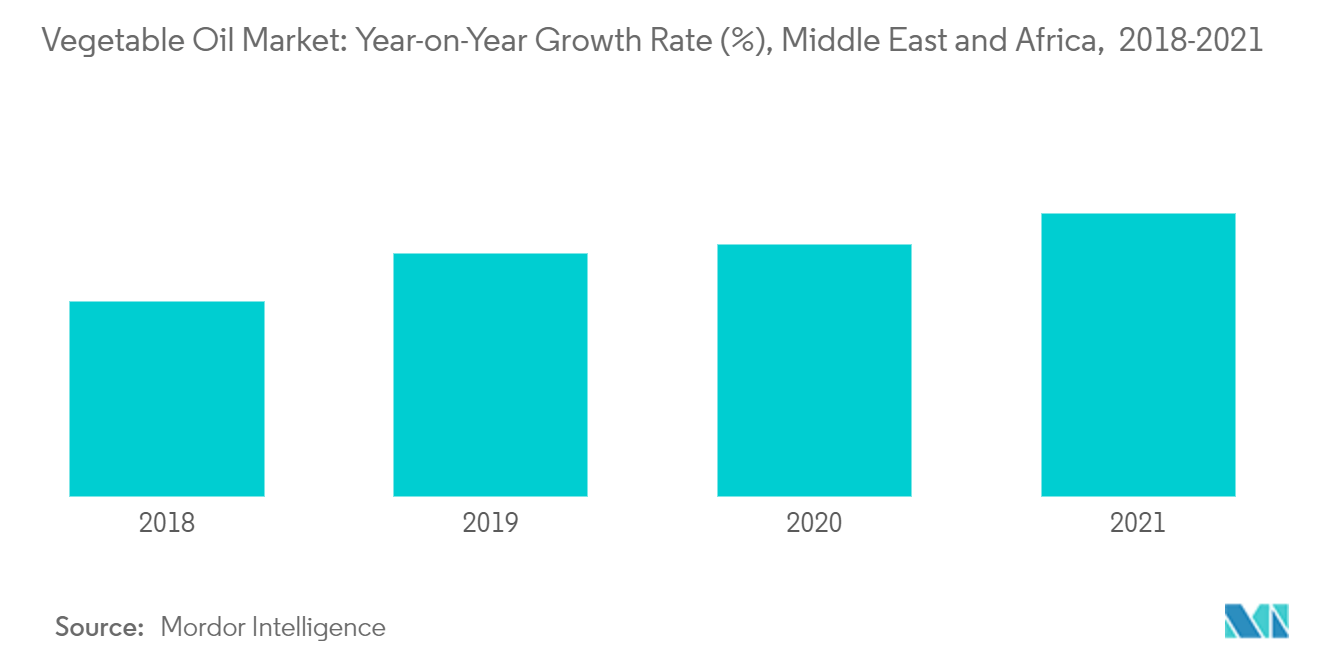
MEA Vegetable Oil Industry Overview
The Middle-East and Africa vegetable market is a highly competitive market with the presence of various major and local players. The most active companies in the Middle East and Africa vegetable oils market are ADVOC (ABU DHABI VEGETABLE OIL COMPANY), Amira Nature Foods Ltd, Wilmar International Limited, and Cargill, Incorporated, among others. The active companies in the market have adopted product innovation as a strategy due to changing consumer preferences in the region. The major focus of the companies is to offer products with a wider application range aiding all feed, food and beverage, and industrial sectors, thereby, catering consumers' preferences efficiently. Moreover, the companies have adopted continuous expansion as their strategy to achieve a competitive advantage in the market and expand their geographical presence and customer base.
MEA Vegetable Oil Market Leaders
-
Cargill, Incorporated
-
Sime Darby Plantation Berhad
-
Wilmar International Limited
-
Amira Nature Foods Ltd
-
ADVOC (ABU DHABI VEGETABLE OIL COMPANY)
*Disclaimer: Major Players sorted in no particular order
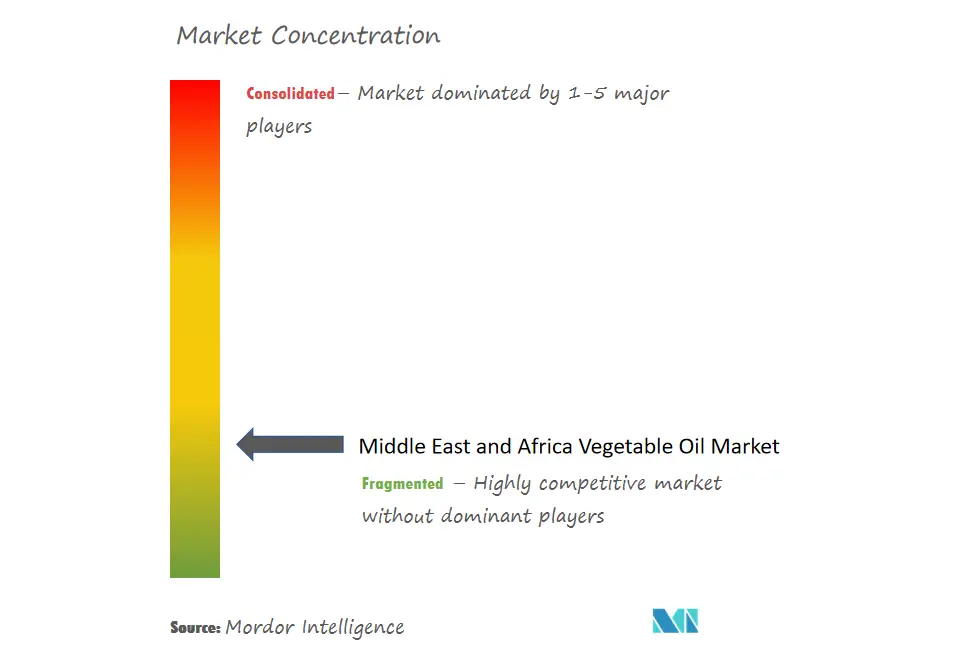
MEA Vegetable Oil Market News
- In 2021, Al Ghurair announced that they are acquiring (EOCD), 'Edible Oil Company LLC' which is a major company in multi-seed, crushing over the regions of the Middle -East. Signing this deal is to expand its resources and business operations over Dubai and other Middle-Eastern countries.
- In 2021, Archer Daniels Midland Co. announced the deal with Marathon Petroleum Corp. to construct a joint venture for manufacturing soybean oil to supply the speedily increasing demand for renewable diesel fuel. ADM has a deal with MPC in order to cater to the rising demand for soybean oil in the regions of the Middle-East.
- In 2019, Sime Darby Oils and Abu Dhabi Vegetable Oil Company entered into a strategic partnership to market oils and fats products in the Middle East and North African (MENA) region, where both the companies will operate as a single sales and marketing team.
MEA Vegetable Oil Market Report - Table of Contents
1. INTRODUCTION
- 1.1 Study Assumptions and Market Definition
- 1.2 Scope of the Study
2. RESEARCH METHODOLOGY
3. EXECUTIVE SUMMARY
4. MARKET DYNAMICS
- 4.1 Market Drivers
- 4.2 Market Restraints
-
4.3 Porter's Five Forces Analysis
- 4.3.1 Threat of New Entrants
- 4.3.2 Bargaining Power of Buyers/Consumers
- 4.3.3 Bargaining Power of Suppliers
- 4.3.4 Threat of Substitute Products
- 4.3.5 Intensity of Competitive Rivalry
5. MARKET SEGMENTATION
-
5.1 By Product Type
- 5.1.1 Palm Oil
- 5.1.2 Soybean Oil
- 5.1.3 Rapeseed Oil
- 5.1.4 Sunflower Oil
- 5.1.5 Olive Oil
- 5.1.6 Other Product Types
-
5.2 By Application
- 5.2.1 Food
- 5.2.2 Feed
- 5.2.3 Industrial
-
5.3 By Geography
- 5.3.1 South Africa
- 5.3.2 United Arab Emirates
- 5.3.3 Rest of Middle-East and Africa
6. COMPETITIVE LANDSCAPE
- 6.1 Most Active Companies
- 6.2 Market Positioning
-
6.3 Company Profiles
- 6.3.1 Cargill Incorporated
- 6.3.2 ADVOC (ABU DHABI VEGETABLE OIL COMPANY)
- 6.3.3 Sime Darby Plantation Berhad
- 6.3.4 Wilmar International Limited
- 6.3.5 Omani Vegetable Oils & Derivatives Co.(L.L.C)
- 6.3.6 Amira Nature Foods Ltd
- 6.3.7 AJWA Group
- 6.3.8 Archer Daniels Midland Co.
- 6.3.9 Al Ghurair
- 6.3.10 Edible Oil Company LLC
- *List Not Exhaustive
7. MARKET OPPORTUNITIES AND FUTURE TRENDS
8. IMPACT OF COVID-19 ON THE MARKET
** Subject To AvailablityMEA Vegetable Oil Industry Segmentation
The Middle-East and Africa vegetable oil market has been segmented by product type, which includes palm oil, soybean oil, rapeseed oil, sunflower oil, olive oil, and other product types. Based on application, the market is segmented into food, feed, and industrial. The study also involves the regional level analysis of the main countries such as South Africa, the United Arab Emirates, and Rest of Middle-East and Africa. For each segment, the market sizing and forecasts have been done on the basis of value (in USD million).
| By Product Type | Palm Oil |
| Soybean Oil | |
| Rapeseed Oil | |
| Sunflower Oil | |
| Olive Oil | |
| Other Product Types | |
| By Application | Food |
| Feed | |
| Industrial | |
| By Geography | South Africa |
| United Arab Emirates | |
| Rest of Middle-East and Africa |
MEA Vegetable Oil Market Research FAQs
What is the current Middle-East and Africa Vegetable Oil Market size?
The Middle-East and Africa Vegetable Oil Market is projected to register a CAGR of 4.31% during the forecast period (2024-2029)
Who are the key players in Middle-East and Africa Vegetable Oil Market?
Cargill, Incorporated, Sime Darby Plantation Berhad, Wilmar International Limited, Amira Nature Foods Ltd and ADVOC (ABU DHABI VEGETABLE OIL COMPANY) are the major companies operating in the Middle-East and Africa Vegetable Oil Market.
What years does this Middle-East and Africa Vegetable Oil Market cover?
The report covers the Middle-East and Africa Vegetable Oil Market historical market size for years: 2019, 2020, 2021, 2022 and 2023. The report also forecasts the Middle-East and Africa Vegetable Oil Market size for years: 2024, 2025, 2026, 2027, 2028 and 2029.
MEA Vegetable Oil Industry Report
Statistics for the 2024 MEA Vegetable Oil market share, size and revenue growth rate, created by Mordor Intelligence™ Industry Reports. MEA Vegetable Oil analysis includes a market forecast outlook to 2029 and historical overview. Get a sample of this industry analysis as a free report PDF download.



